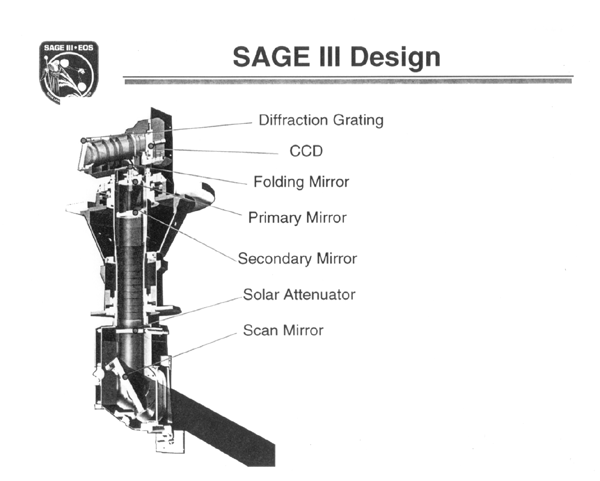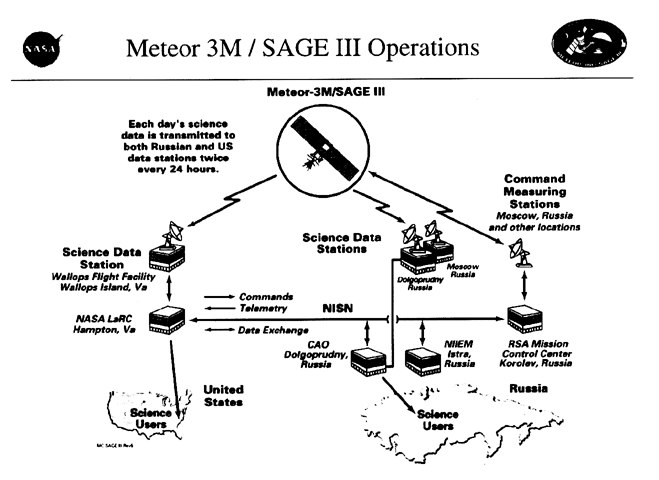 |
Report on SAGE-III scientific seminar |
 |
Scientific seminar of scientists of
USA and Russia "SAGE-III Test Data Review Meeting" has been hold on
1-2 March, 2001 in St. Petersburg State University. Eleven scientists from USA
participated in this seminar after the completion of the Moscow stage of the
SAGE-III testing (see list of participants in
Attachment 1).
Scientists of Atmospheric Physics Department at St. Petersburg State University
participated in the seminar from Russian side. William Chu, Alvah Moore (USA)
and Yu.M. Timofeyev were put in to manage the seminar.

Participants of SAGE-III seminar
Seminar Program (see
Attachment 2) icluded the following items:
- Scientific statement of satellite experiment with the SAGE-III.
- Reports on testing the device.
- Ideology of systems of processing the measurement data of different levels.
- Review of scientific results in the field of remote sensing at Atmospheric
Physics Department (SPbSU).
American scientists arrived in SPbSU
after long Moscow period dedicated to pre-flight SAGE-III tests. After the seminar,
they returned to Moscow to complete all the program of the SAGE-III tests.
The SAGE-III is planned to be launched in June-July 2001 in the
complex of the "Meteor-3M" scientific technique.
W.Chu gave a short characteristics of previous experiments on
atmospheric sounding (aerosol, gas content) from 1975 (SAM apparatus). In Table "SAGE
III Heritage" principal characteristics of different satellite experiments are
given.

Table 1. "SAGE III Heritage"
Considered satellite experiments are
the measurements of solar radiation passing through the atmosphere along slant
paths at Sun rises or sets. The solution of relevant inverse problem gives a
possibility to determine vertical profiles of the ozone and other atmospheric
components and to retrieve some optical and microphysical aerosol characteristics.
It will be noted that American satellite experimants of such type provides a
great amount of valuable scientific information. It is necessary to pay attention
on unique duration of a number of the SAM-II and SAGE-II experiments. For example,
the SAGE-II has been worked from 1984 in spite of the collapse of some ERBS
systems.
In Russia similar experiments are few. In this connection we can
cite the paper of K.Ya. Kondratyev et al. "Measurements of stratospheric
and mesospheric water vapor mixing ratio by spectral device from orbital station
"Salyut-4" (Reports of RAS, 1976, 266, 3, 563-565).
A number of experiments with the "Ozone-Mir" device similar
to SAGE-III were performed from the "Mir" Orbital Station. Principal
results of this experiment were published:
- Poberovskii, A.V., A.V. Polyakov, Yu.M. Timofeyev et al., 1999: Determination
of vertical profiles of the ozone content by the occultation method from
the "MIR" Orbital Station: 1. Description of instrumentation and
data processing method. Examples of results. Izv., Atm.. Ocean. Phys., 35,
3, 312-321 (Engl. transl.).
- Polyakov A.V., A.V. Poberovskii, Yu.M. Timofeyev, 1999: Ozone Profile
Determination by Occultation Sounding from the Mir Space Station: 2. Comparison
of the Observational Results with Independent Data., Izv., Atm.. Ocean.
Phys., 35, 3, 322-328 (Engl. transl.).
- Polyakov, A.V., A.V. Vasil'ev, and Yu. M. Timofeev, 2001: Parametrization
of the Spectral Dependence of the Aerosol Attenuation Coefficient in Problems
of Atmospheric Occultation Sounding from Space. Izv., Atm.. Ocean. Phys.,
37, 5, 646-657 (Engl. transl.).
- Polyakov A.V., Yu.M.Timofeev, A.V.Poberovkii, and A.V.Vasil'ev, 2001:
Retrieval of Stratospheric Vertical Profiles of Aerosol Extinction Coefficients
from the Ozon-Mir Measurements (Mir Space Station), Izv. RAN, Atm. and Oceanic
Physics, 37, 2, 213-222.
Scientists of different countries participate in the SAGE-III Project.
Prof. A.A. Chernikov (CAO) and Prof. N.F. Elanski (OIAP RAS). The list of the
SAGE-III Project scientists are given below.
|
Investigators
M.P. McCormick, Principal
Investigator
W.P. Chu, Project Scienyist
A.A. Chernikov
D.M.
Gunnold
J. DeLuisi
P.A. Durkee
N.P. Elanski
B.M.
Herman
P.V. Hobbs
G. Kent
J. Lenoble/C. Brogniez
A.J.
Miller
V. Mohnen
V. Ramaswamy
D. Rind
P.B. Russel
V.
Saxen
E.P. Shettle
L. Thomason
C. Trepte
G. Vali
S.C.
Wofsy
J.M. Zawodny |
|
Affiliation
Hampton University
NASA
Langley
Central Aerological Observatory
Georgia Institute of
Technology
NOAA/ERL
Naval Postgraduate School
Russian Academy of
Science
University of Arizona
University of Washington
Science
and Technology Ñorp.
University of Lille
NOAA NCEP
New York State
University
Princeton University
NASA GISS
NASA Ames
North
Carolina State University
Naval Research Lab.
NASA Langley
NASA
Langley
University of Wyoming
Harvard University
NASA Langley
|
Principal characteristics of the SAGE-III
are:
- Near UV, visible, to near IR radiometer with target pointing capability
- Instrument and sensor operations all software controlled
- CCD detector with spectral resolution of about 1 nm accross the visible
- Can perform vertical scanning with IFOV of 0.5 arcmin
- Accommodate signal dynamic tange from direct solar to half moon signal
The SAGE-III design is given in Fig.1.

Fig.1. SAGE-III design
In Table 2 principal information on
atmospheric parameters planned to be determined by the SAGE-III are given.

Table 2. SAGE-III Science Performance
The scheme illustrating the organization
of the receipt, the propagation and the processing of measurement data is given.

Fig.2. Meteor-3M/ SAGE-III operation
By desire of USA scientists, SPbSU team
reported some results of investigations:
- Timofeyev Yu.M. A review of studies in the field of remote sensing at
Atmospheric Physics Department.
- Kostsov V.S. Retrieval of vertical temperature profiles at the 40-120
km altitudes (the interpretation of the "CRISTA" measurement data).
- Virolainen Ya.A. Determination of atmospheric temperature and gas characteristics
from ground-based measurements of thermal radiation spectra.
- Ionov D.V. Results of validating the satellite measirements of O3 and
NO2 total contents by the GOME device.
- Polyakov A.V. à) Experiment with the "Ozone-Mir" device. á)
Optimal parametrization of stratospheric spectral aerosol extinction coefficient
and the solution of inverse problem with respect to aerosol microphysical
parameters.
The Russian-merican seminar was successful and American colleagues
acknowledged the SPbSU for holding the meeting.
- Robert Borchardt, Science Application International Corporation, SAGE III
Flight Software Engineer
- Obia Bradley, NASA Langley Research Center, SAGE III Instrument Manager
- William Chu, NASA Langley Research Center, SAGE III Project Scientist and
Associate Principal Investigator
- Michael Cisewski, G&A Technical Software, Incorporated, SAGE III
Mission Operations Manager
- Art Hayhurst, NASA Langley Research Center, SAGE III Quality Assurance
Engineer
- Alvah Moore, NASA Langley Research Center, SAGE III Project Manager
- Nicholas Pokrovsky, Language Services Associates, Aerospace, Interpreter
- John Quinn, NASA Langley Research Center, SAGE III Integration and Test
Engineer
- Richard Rawls, NASA Langley Research Center, SAGE III Integration and
Testing Manager
- Vladimir Shargorodsky, Language Services Associates, Aerospace,
Interpreter
- Robert Veiga, Science Application International Corporation, SAGE III
Calibration Manager
Proposed Agenda:
MARCH 1 MorningSAGE
III US Team Arrive in St. Petersburg
MARCH 1 AfternoonTEST
DATA REVIEW (1/2 Day)
OPENING REMARKS - (St. Petersburg State
University)
INSTRUMENT READINESS
Introductions (Moore, Chu)
Overview and Expectations from
review (Moore)
Review all instrument test results (Quinn, Veiga,
Rawls)
Break
Review End-to-End Test results (Cisewski)
Overview of
EMC/EMI test plan (Rawls)
NFR's/Resolutions (Hayhurst)
Review of Day
2's Agenda / Closing (Moore)
MARCH 2 - (1/2
Day) PRE-SHIP STATUS
Status of logistics/materials/equipment (Rawls)
Shipping Plan
and Activities (Rawls)
Open issues (All)
Closing remarks
(Moore/Chu)
Dismiss I&T Team
SCIENCE DATA
OVERVIEW
SAGE III Radiometric Calibration and Test Data (Chu)
Ozon-Mir
Occultation Experiments and Validation Programs (SPSU)
MARCH 3, 4SAGE III US Team Members Non Work
Days
MARCH 5SAGE III US Team Members Return to Moscow
RRC site - 2001 © Designed by Aleksei Semenov








